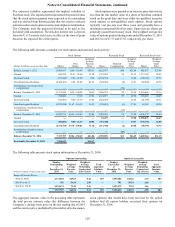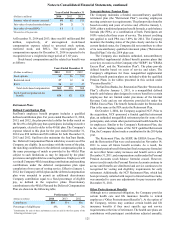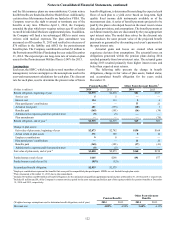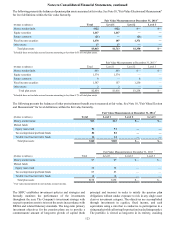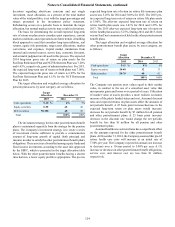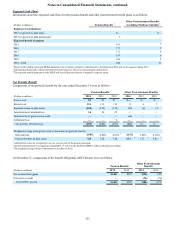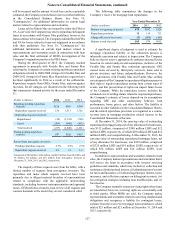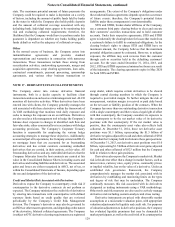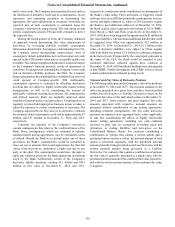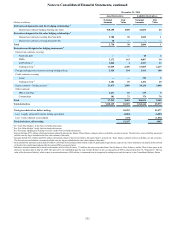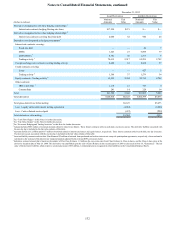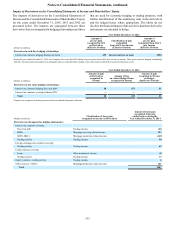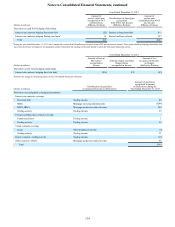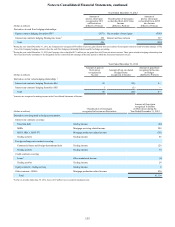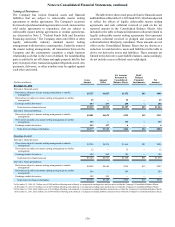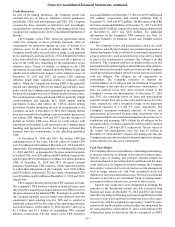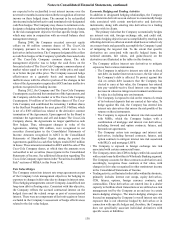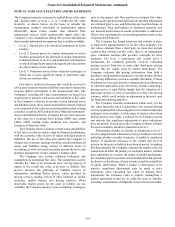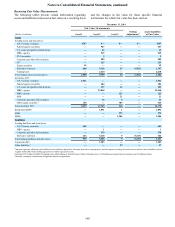SunTrust 2014 Annual Report Download - page 153
Download and view the complete annual report
Please find page 153 of the 2014 SunTrust annual report below. You can navigate through the pages in the report by either clicking on the pages listed below, or by using the keyword search tool below to find specific information within the annual report.Notes to Consolidated Financial Statements, continued
130
and its own credit. The Company has considered factors such as
the likelihood of default by itself and its counterparties, its net
exposures, and remaining maturities in determining the
appropriate fair value adjustments to recognize. Generally, the
expected loss of each counterparty is estimated using the
Company’s internal risk rating system. The risk rating system
utilizes counterparty-specific PD and LGD estimates to derive
the expected loss.
During the fourth quarter of 2014, the Company enhanced
its approach toward determining fair value adjustments of
derivatives by leveraging publicly available counterparty
information. In particular, for purposes of determining the CVA,
the Company started incorporating market-based views of
counterparty default probabilities derived from observed credit
spreads in the CDS market when data of acceptable quality was
available. This enhanced approach did not have a material impact
on the Company's financial position, results of operations, or
cash flows. For purposes of estimating the Company’s own credit
risk on derivative liability positions, the DVA, the Company
began using market-based probabilities of default from observed
credit spreads of Company-specific CDS. Additionally,
counterparty exposure is evaluated by offsetting derivatives
positions that are subject to legally enforceable master netting
arrangements, as well as by considering the amount of
marketable collateral securing the positions. All counterparties
and defined exposure limits are explicitly approved under
established internal policies and procedures. Counterparties are
regularly reviewed and appropriate business action is taken to
adjust the exposure to certain counterparties as necessary. The
Company adjusted the net fair value of its derivative contracts
for estimates of net counterparty credit risk by approximately $7
million and $13 million at December 31, 2014 and 2013,
respectively.
Currently, the majority of the Company’s derivatives
contain contingencies that relate to the creditworthiness of the
Bank. These contingencies, which are contained in industry
standard master netting agreements, may be considered events
of default. Should the Bank be in default under any of these
provisions, the Bank’s counterparties would be permitted to
close-out net at amounts that would approximate the then-fair
values of the derivatives, resulting in a single sum due by one
party to the other. The counterparties would have the right to
apply any collateral posted by the Bank against any net amount
owed by the Bank. Additionally, certain of the Company’s
derivative liability positions, totaling $1.1 billion and $941
million in fair value at December 31, 2014 and 2013,
respectively, contain provisions conditioned on downgrades of
the Bank’s credit rating. These provisions, if triggered, would
either give rise to an ATE that permits the counterparties to close-
out net and apply collateral or, where a CSA is present, require
the Bank to post additional collateral. At December 31, 2014,
the Bank carried senior long-term debt ratings of A3/A-/BBB+
from Moody’s, S&P, and Fitch, respectively. At December 31,
2014, ATEs have been triggered for approximately $1 million in
fair value liabilities. The maximum additional liability that could
be triggered from ATEs was approximately $27 million at
December 31, 2014. At December 31, 2014, $1.1 billion in fair
value of derivative liabilities were subject to CSAs, against
which the Bank has posted $1.0 billion in collateral, primarily
in the form of cash. If requested by the counterparty pursuant to
the terms of the CSA, the Bank would be required to post
estimated additional collateral against these contracts at
December 31, 2014, of $20 million if the Bank were downgraded
to Baa3/BBB-. Further downgrades to Ba1/BB+ or below do not
contain predetermined collateral posting levels.
Notional and Fair Value of Derivative Positions
The following tables present the Company’s derivative positions
at December 31, 2014 and 2013. The notional amounts in the
tables are presented on a gross basis and have been classified
within Asset Derivatives or Liability Derivatives based on the
estimated fair value of the individual contract at December 31,
2014 and 2013. Gross positive and gross negative fair value
amounts associated with respective notional amounts are
presented without consideration of any netting agreements,
including collateral arrangements. Net fair value derivative
amounts are adjusted on an aggregate basis, where applicable,
to take into consideration the effects of legally enforceable
master netting agreements, including any cash collateral
received or paid, and are recognized in trading assets and
derivatives or trading liabilities and derivatives on the
Consolidated Balance Sheets. For contracts constituting a
combination of options that contain a written option and a
purchased option (such as a collar), the notional amount of each
option is presented separately, with the purchased notional
amount generally being presented as an Asset Derivative and the
written notional amount being presented as a Liability
Derivative. For contracts that contain a combination of options,
the fair value is generally presented as a single value with the
purchased notional amount if the combined fair value is positive,
and with the written notional amount, if the combined fair value
is negative.


